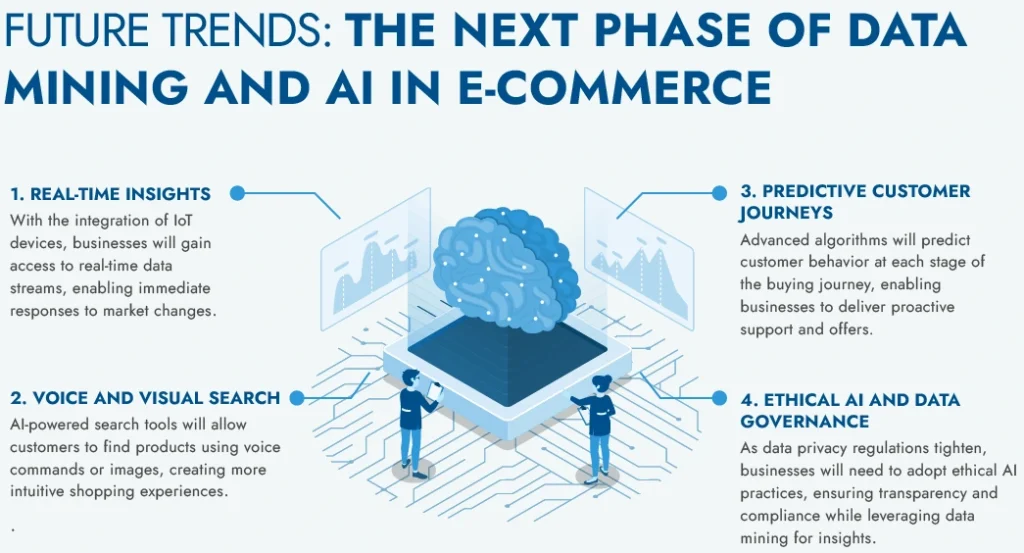
Data mining allows businesses to identify distinct customer groups by analyzing purchasing behaviors, demographic attributes, and online activities. By segmenting customers effectively, businesses can create personalized experiences that drive engagement and loyalty.
Techniques like K-means clustering are instrumental in grouping customers based on shared characteristics, such as purchasing patterns, browsing behaviors, or product preferences. This approach helps marketers design hyper-focused campaigns that resonate with each group. For instance, segmentation might identify a cohort of budget-conscious shoppers versus high-value buyers, allowing personalized messaging and discounts tailored to their specific needs. Such precision not only improves campaign relevance but also enhances ROI by minimizing wasted efforts on poorly targeted audiences.
Behavioral analysis models delve into clickstream data, shopping cart interactions, and time spent on product pages to uncover subtle preferences. By identifying patterns like frequently abandoned carts or products viewed multiple times, these models help e-commerce businesses predict customer intent. Insights from these behaviors can inform strategies such as retargeting ads, product bundling, or exclusive promotions to convert hesitant shoppers. Integrating AI with behavioral models further enables dynamic adjustments based on real-time user actions, ensuring timely engagement.
An e-commerce platform leverages customer segmentation by analyzing purchasing habits of high-value customers who frequently buy luxury goods. With this data, it designs personalized email campaigns offering exclusive discounts or early access to premium collections. This targeted approach results in higher engagement rates, increased conversions, and enhanced customer loyalty, demonstrating the strategic value of tailored marketing efforts driven by data insights.






The integration of AI and Data Mining has transformed the way businesses analyze and utilize data, especially in the fast-paced e-commerce sector. By automating repetitive tasks, refining predictions, and extracting actionable insights from unstructured data, AI significantly amplifies the effectiveness of traditional data mining techniques. This synergy ensures businesses can scale their operations while maintaining efficiency and precision.
The integration of Data Mining and AI in e-commerce is revolutionizing operations, from personalized customer experiences to streamlined inventory management. However, leveraging this synergy presents unique challenges. Businesses often grapple with fragmented data sources, ensuring data quality, scalability concerns, and the need for real-time processing to meet customer expectations. Additionally, aligning these technologies with evolving business goals demands strategic planning and technical expertise. Addressing these challenges is crucial to unlocking the full potential of Data Mining and AI for e-commerce optimization.

Data Integration: APIs and data connectors bring in information from different platforms.
AI-Driven Standardization: AI maps and organizes the data into a unified format.
Centralized Access: A centralized platform provides real-time access to consolidated insights, empowering teams with a complete view of customer behavior.


Cloud Migration: Data is moved to cloud platforms that support distributed processing.
Dynamic Scaling: AI monitors workload demands and allocates resources dynamically, ensuring seamless performance.
Real-Time Processing: Distributed computing enables businesses to analyze data streams in real time, such as customer browsing behavior or live sales trends.

Data Validation: AI identifies discrepancies such as duplicate entries or missing fields.
Automated Correction: Machine learning models fill gaps using predictive methods or flag issues requiring human intervention.
Continuous Monitoring: Real-time data quality checks ensure that new entries meet predefined standards.


Requirement Analysis: Collaborate with stakeholders to define the business’s specific needs.
Solution Design: Develop AI algorithms and workflows tailored to these requirements.
Seamless Integration: Ensure the custom system integrates with existing infrastructure, such as ERP or CRM platforms.



Tailored Workflows: Adapt AI systems to fit your unique processes, maximizing operational efficiency.
Enhanced Compatibility: Ensure seamless integration with your current platforms for smoother operations.
Future-Proofing: Stay ahead with solutions that evolve alongside market trends and business growth.

| Cookie | Duration | Description |
|---|---|---|
| __cf_bm | 1 hour | This cookie, set by Cloudflare, is used to support Cloudflare Bot Management. |
| _cfuvid | session | Calendly sets this cookie to track users across sessions to optimize user experience by maintaining session consistency and providing personalized services |
| cookielawinfo-checkbox-advertisement | 1 year | Set by the GDPR Cookie Consent plugin, this cookie records the user consent for the cookies in the "Advertisement" category. |
| cookielawinfo-checkbox-analytics | 11 months | This cookie is set by GDPR Cookie Consent plugin. The cookie is used to store the user consent for the cookies in the category "Analytics". |
| cookielawinfo-checkbox-functional | 11 months | The cookie is set by GDPR cookie consent to record the user consent for the cookies in the category "Functional". |
| cookielawinfo-checkbox-necessary | 11 months | This cookie is set by GDPR Cookie Consent plugin. The cookies is used to store the user consent for the cookies in the category "Necessary". |
| cookielawinfo-checkbox-others | 11 months | This cookie is set by GDPR Cookie Consent plugin. The cookie is used to store the user consent for the cookies in the category "Other. |
| cookielawinfo-checkbox-performance | 11 months | This cookie is set by GDPR Cookie Consent plugin. The cookie is used to store the user consent for the cookies in the category "Performance". |
| CookieLawInfoConsent | 1 year | CookieYes sets this cookie to record the default button state of the corresponding category and the status of CCPA. It works only in coordination with the primary cookie. |
| viewed_cookie_policy | 11 months | The cookie is set by the GDPR Cookie Consent plugin and is used to store whether or not user has consented to the use of cookies. It does not store any personal data. |
| wpEmojiSettingsSupports | session | WordPress sets this cookie when a user interacts with emojis on a WordPress site. It helps determine if the user's browser can display emojis properly. |
| Cookie | Duration | Description |
|---|---|---|
| li_gc | 6 months | Linkedin set this cookie for storing visitor's consent regarding using cookies for non-essential purposes. |
| lidc | 1 day | LinkedIn sets the lidc cookie to facilitate data center selection. |
| wp-wpml_current_language | session | WordPress multilingual plugin sets this cookie to store the current language/language settings. |
| yt-remote-cast-installed | session | The yt-remote-cast-installed cookie is used to store the user's video player preferences using embedded YouTube video. |
| yt-remote-connected-devices | never | YouTube sets this cookie to store the user's video preferences using embedded YouTube videos. |
| yt-remote-device-id | never | YouTube sets this cookie to store the user's video preferences using embedded YouTube videos. |
| yt-remote-fast-check-period | session | The yt-remote-fast-check-period cookie is used by YouTube to store the user's video player preferences for embedded YouTube videos. |
| yt-remote-session-app | session | The yt-remote-session-app cookie is used by YouTube to store user preferences and information about the interface of the embedded YouTube video player. |
| yt-remote-session-name | session | The yt-remote-session-name cookie is used by YouTube to store the user's video player preferences using embedded YouTube video. |
| ytidb::LAST_RESULT_ENTRY_KEY | never | The cookie ytidb::LAST_RESULT_ENTRY_KEY is used by YouTube to store the last search result entry that was clicked by the user. This information is used to improve the user experience by providing more relevant search results in the future. |
| Cookie | Duration | Description |
|---|---|---|
| _ga | 1 year 1 month 4 days | Google Analytics sets this cookie to calculate visitor, session and campaign data and track site usage for the site's analytics report. The cookie stores information anonymously and assigns a randomly generated number to recognise unique visitors. |
| _ga_* | 1 year 1 month 4 days | Google Analytics sets this cookie to store and count page views. |
| _gcl_au | 3 months | Google Tag Manager sets the cookie to experiment advertisement efficiency of websites using their services. |
| _li_id | 2 year | Leadinfo places two cookies that only provides Eastern Enterprise insights into the behaviour on the website. These cookies will not be shared with other parties. |
| Cookie | Duration | Description |
|---|---|---|
| bcookie | 1 year | LinkedIn sets this cookie from LinkedIn share buttons and ad tags to recognize browser IDs. |
| guest_id | 1 year 1 month | Twitter sets this cookie to identify and track the website visitor. It registers if a user is signed in to the Twitter platform and collects information about ad preferences. |
| test_cookie | 15 minutes | doubleclick.net sets this cookie to determine if the user's browser supports cookies. |
| VISITOR_INFO1_LIVE | 6 months | YouTube sets this cookie to measure bandwidth, determining whether the user gets the new or old player interface. |
| VISITOR_PRIVACY_METADATA | 6 months | YouTube sets this cookie to store the user's cookie consent state for the current domain. |
| YSC | session | Youtube sets this cookie to track the views of embedded videos on Youtube pages. |
| yt.innertube::nextId | never | YouTube sets this cookie to register a unique ID to store data on what videos from YouTube the user has seen. |
| yt.innertube::requests | never | YouTube sets this cookie to register a unique ID to store data on what videos from YouTube the user has seen. |
| Cookie | Duration | Description |
|---|---|---|
| __Secure-ROLLOUT_TOKEN | 6 months | Description is currently not available. |
